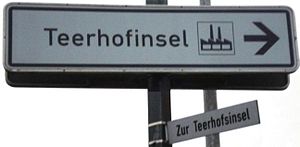Teerhofinsel
| Teerhofinsel | ||
|---|---|---|
| Waters | Trave | |
| Geographical location | 53 ° 54 ' N , 10 ° 42' E | |
|
|
||
| Information and road sign | ||
The Teerhofinsel , also known as the Teerhof Island , popularly known as Cameroon at the end of the 19th century , is located in the Trave below Lübeck . It was created when the course of the river was corrected in 1882. A puncture significantly shortened the route from the Lübeck Bay of the Baltic Sea to the Lübeck city harbor. The peninsula , which originally belonged to the St. Gertrud district, has since become an island in the St. Lorenz Nord district .
In the northern oxbow lake and in the petroleum port to the south - separated from it by a dam - there are several yacht harbors and a boat building.
For a time it was planned to expand the Lübeck port area in the area of the Teerhofinsel. In the course of the expansion of the Vorwerker port by the Lübeck port company , through which the port of Lübeck handles most of the traffic with Finland , the port area was planned to be expanded. The old arm of the Trave was to be partially filled in to connect these expansion areas with the existing areas of the Nordlandkai . Due to the falling freight rates and the long trips to the area, there was less and less interest on the part of the shipping companies in carrying out this expansion.
origin of the name
The name is derived from the Lübeck Teerhof , which was formerly located there .
(Wood) tar was an important commodity that was mainly imported from Scandinavia . Since tar is very flammable, the Teerhof was laid out for storage outside the city of Lübeck.
In the days of sailing , the cordage was protected from rotting by tar. In addition, tar was used to seal the joints between the planks of the ship's hulls ( caulking ). Tar was therefore of paramount importance for the safety of ships. Therefore, by decision of the council of the Hanseatic city, the taring of cordage in Lübeck took place under the central supervision of the city in the Teerhof.
history
The first tar farm was set up in Lübeck around 1400 on the northern wall peninsula . The freshly tarred ropes were then dried in the trough . In 1845 (against the background of the Hamburg fire ), the Teerhof was initially relocated further down the Trave to the north, and was finally relocated in 1883 to the Teerhof Island, which was created in the course of the correction of the Trave in 1882.
In 1890 there was one closed and two open sheds for tar, one closed for kerosene , a massive building for powder, one in the ground for dynamite and a shed for fireworks. There was also an administration building, apartments for the tar tractors and workers. The German-Russian Naphta Import Company owned two tanks, a closed shed, administration building and workers' apartments on the Teerhof Island.
Later the Teerhofinsel became a restricted military area. The pioneers from the nearby Travelodge barracks used the training area Teerhofinsel including as water exercise course. In addition to the Bundeswehr , the Federal Border Police also practiced there .
literature
- Helmut von der Lippe : Wagons and Wagons: From the tradition of Lübeck Kauffmanns-Compagnien . Lübeck 1984, p. 58-59 .

